Jax
If you are interested in sharing an AirBnB with me near Huguenot Memorial Park east of Jacksonville, FL during the second week of July, or in doing an IPT that week, please stop what you are doing and shoot me an e-mail. Big discount for the person who shares the AirBnB with me. IPT details below. Here’s wishing you great light and better photography.
Flight Photography at Jacksonville Till You Can’t Lift Your Lens!
Join me on the beach at Huguenot Memorial Park to learn about photographing terns in flight. 8,000 pairs of Royal Terns nest there and there are birds in the air all the time, often carrying all kinds of fish and crabs and other invertebrates for their young. Learn about how the relationship between the wind and the sun impacts flight photography and about the best gear for shooting birds in flight. Note that all the images in the video were created with the Sony a1 (and a variety of lenses). Join me on a workshop at Jacksonville this summer. See the details below.
What’s Up?
The high winds continue in west/central North Dakota. Thursday was another rest day and Friday will be more of the same. On Thursday afternoon we visited the home of Kevin’s friend, Lugene Gerber and her significant other, Doug Kitzan. Lujene loves to photograph birds but loves cooking great food and serving friends even more. Included were salad with a scrumptious homemade ranch dressing, a killer spinach dip, roasted smoked turkey that tasted like a Christmas ham, Italian shrimp, and olive and pickle plate, her aptly named “Funeral” potatoes, and tasty, greasy fried chicken that was much better than the colonels! Most folks ate two desserts one of which was the hugely popular lemon pudding cake. I limited myself to one slice of chocolate-drizzled coffee cheesecake (AKA Caramel Machiatto cheesecake). Suffice to say, I needed a lot of extra insulin after that amazing meal.
Today is Friday 19 April 2024. If the forecast does not change, it is likely that we will be transporting the blinds to the Sharp-tailed Grouse lek about 30 minutes from Kevin’s home.
|
|
|
Clockwise from upper left corner around to center: ink-stained Royal Tern with squid for chicks; fluffy white Royal Tern Chick about two weeks old; Royal Tern with shrimp for chicks; 3-4 week old Royal Tern chick; incoming adult Royal Tern with greenback; Royal Tern in flight with juvenile mahi-mahi; large Brown Pelican chick preening; field guide portrait of fresh juvenile Laughing Gull; Royal Tern chick begging for fish from incoming adult. Join me at Huguenot Memorial Park this July |
Join Me
I have an AirBnB checking in on the late afternoon of Saturday 13 July and checking out on Thursday 19 July 2024. If you are looking to improve your bird photography by leaps and bounds while sharing the place with me, please shoot me an e-mail. ASAP.
|
|
|
Clockwise from upper left corner around to center: Royal Tern chick feeding frenzy; Royal Tern nearly fledged chick; ink-stained Royal Tern with squid for chicks; Royal Tern chick begging; Brown Pelican immature tight flight; Royal Tern adult screaming — tight flight; Laughing Gulls mobbing Royal Tern to steal fish; Royal Tern with fish for chicks. Join me at Huguenot Memorial Park this July |
Huguenot Memorial Park in Early Summer
Driving on the beach at Huguenot Memorial Park in early summer is a bird photographer’s delight. You park this side of the last rope on the beach and you are within 100 yards of the Royal Tern colony atop the dunes. There are also many thousand Laughing Gulls and a few Sandwich Terns breeding as well. In some years, there are some Brown Pelican nests on the ground! .
In early July, the tern chicks begin to make their way down to the flats to bathe and drink and get fed by the parents. On the way, they spend a lot of time on the face of the dune where they are easy to photograph at eye level. They may also gather in fairly large groups at the base of the dunes.
Flight photography both in the mornings and the afternoons can be quite excellent as the terns are carrying all manner of marine life to sustain the rapidly growing chicks: the adults are often seen flying around in search of their chicks with all sorts of small baitfish as well as immature fish, large shrimps, baby crabs, and even squid in their bills. The squid will squirt ink on the terns in protest. So if you see an adult Royal Tern flying around with a black necklace you can understand why.
2024 Jacksonville IPT: 4 1/2 DAY option Monday 15 July 2024 through the morning session on FRI 19 JULY — $2299.00 (Limit 4 photographers)
2024 Jacksonville IPT 3 1/2 DAY option: Monday 15 July 2024 through the morning session on THUR 18 July: $1799.00. (Limit 4 photographers)
I do not like to disappoint: each trip will run with only a single participant. If necessary.
I first visited the beach nesting bird colony at Jacksonville in late June 2021. I was astounded. There were many thousands of pairs of Royal Terns nesting along with about 10,000 pairs of Laughing Gulls. In addition to the royals, there were some Sandwich Terns nesting. And there are several dozen pairs of Brown Pelicans nesting on the ground. Flight photography was non-stop astounding. And photographing the tern chicks was relatively easy. Folks could do the whole trip with the Sony 200-600, the Canon 100-500 RF, or the Nikon 500 PF or one of the many nw Z lenses. With a TC in your pocket for use on sunny days. Most of the action is within 100 yards of where we park (on the beach). As with all bird photography, there are times when a super-telephoto lens with either TC is the best tool for the job.
Morning sessions will average about three hours, afternoon sessions at least 1 1/2. On cloudy mornings with favorable winds, we may opt to stay out for one long session and skip the afternoon, especially when the afternoon weather forecast is poor. Lunch is included on all but the last day of each IPT and will be served at my AirBnB. After lunch, we will do image review and Photoshop sessions. My AirBnB is the closest lodging to the park.
The deposit is $599.00. Call Jim at the office any weekday at 863-692-0906 to pay by credit card. Balances must be paid by check.
What You Will Learn on a Jacksonville IPT
- 1- First and foremast you will learn to become a better flight photographer. Much better.
- 2-You will learn the basics and fine points of digital exposure. Nikon and Canon folks will learn to get the right exposure every time after making a single test exposure, and SONY folks will learn to use Zebras so that they can be sure of making excellent exposures before pressing the shutter button.
- 3- You will learn to work in Manual exposure mode even if you fear it.
- 4- You will learn to evaluate wind and sky conditions and understand how they affect bird photography, especially the photography of birds in flight.
- 5- You will learn several pro secrets (for each system) that will help you to become a better flight photographer.
- 6- You will learn to zoom out in advance (because the birds are so close!) 🙂
- 7- You will learn how to approach free and wild birds without disturbing them.
- 8- You will learn to spot the good and the great situations.
- 9- You will learn to understand and predict bird behavior.
- 10- You will learn to design pleasing images by mastering your camera’s AF system.
- 11- You will learn to choose the best perspective.
- 12- You will learn to see and control your backgrounds.
- 13- You will learn to see and understand the light.
- 14- You will learn to see and create pleasing blurs in pre-dawn situations.
- 15- You will learn to be ready for the most likely event.
And the best news is that you will be able to take everything you learn home with you so that you will be a better photographer wherever you are and whenever you photograph.
|
|
|
This image was created on 29 June 2021 at Huguenot Memorial Park on a Jacksonville, FL IPT. Standing at full height I used the handheld Sony FE 200-600mm f/5.6-6.3 G OSS lens (at 200mm) and The One, the Sony Alpha 1 Mirrorless digital camera. ) The exposure was determined using Zebra technology with ISO on the Thumb Dial. ISO 640. 1/3200 second at f/7.1 (stopped down 2/3-stop) in Manual Mode. AWB at 9:16:26am on a sunny morning. RawDigger showed the exposure to be dead solid perfect. Tracking: Zone AF-C with Bird Face/Eye Detection performed perfectly. Be sure to click on the image to enjoy a high-res version. Image #1: Royal Tern screaming in flight |
It’s Not Always Easy to Get it Exactly Right in Bird Photography
If you knew that I was using a zoom lens for Image #1, most would react by saying, “You should have zoomed out wider.” As we often get greedy as far as wanting to get as many pixels on the subject as possible, clipping wings and feet and heads is a common occurrence when photographing birds especially birds in flight and in action. Until yesterday, I had long stared at this image thinking of a way to salvage it; I love the bird’s expression. And I had long assumed that I had simply failed to zoom out. That was until I was working on this blog post and saw that the focal length was 200mm, the widest possible.
I gave up trying to think of a way to repair the badly clipped wing and instead, turned to a square crop. WDYT of Image #1?
|
|
|
This image was created on 29 June 2021 at Huguenot Memorial Park on a Jacksonville, FL IPT. I used the Robus RC-5558 Vantage Series 3 Carbon Fiber Tripod/Levered-Clamp FlexShooter Pro-mounted Sony FE 600mm f/4 GM OSS lens, the Sony FE 2.0x Teleconverter, and The One, the Sony Alpha 1 Mirrorless Digital Camera). The exposure was determined via Zebra technology with ISO on the thumb dial. ISO 800. 1/2000 sec. at f/10 (stopped down 2/3-stop) in Manual mode. When evaluated in RawDigger, the raw file brightness was determined to be dead solid perfect. AWB at 9:49:3am on a sunny morning. Tracking: Spot S/AF-C with Bird-Eye/Face Detection performed perfectly. Click on the image to enjoy the high-res version. Be sure to click on the image to enjoy a high-res version. Image #2: Royal Tern with wings raised |
What Do You Think of Square Crops?
Lots of folks think that the-out-of-the-camera 3X2 and 2X3 proportions are sacrosanct and that anything else is heresey. I disagree wholeheartedly. Many images scream out for a square copy, often images with two centered subjects like the Ospreys below. Strangely, I try to avoid boxy crops unless they are the only option.
Framing at 1200mm Ain’t Easy
Especially when you are standing atop an eight foot ladder. I badly mis-framed the original capture for Image #2; the bird on our left was almost touching the frame edge. A square crop resulted in a useable image.
How are Less than Perfect Images and Square Crops Related?
As we have seen in both Image #1 and Image #2, a square crop can often be used to save images that seem to be destined for the trash heap. Or a square crop might be perfect for perfectly executed images, as immediately below.
|
|
|
This image was created on 18 March 2024 down by the lake near my home at Indian Lake Estates, FL. Standing outside my vehicle near the old eagle nest, I used the handheld Sony FE 300mm f/2.8 GM OSS Lens (Sony E) and the ridiculously amazing Sony a9 III Mirrorless Camera. The exposure was determined via Zebra technology with ISO on the Thumb Dial. ISO 1250: 1/3200 sec. at f/2.8 (wide open) in Manual mode. When evaluated in RawDigger, the raw file brightness was pretty darned good. AWB at 9:00:06 on a cloudy morning. Zone/AF-C with Bird Face/Eye detection enabled performed to perfection. Be sure to click on the image to enjoy a high-res version. Ospreys near nest: serendipitous synchronous flight |
Bingo!
So, was this image the result of pure luck or the right gear?
Actually, it was a combination of both. And more. Note that I had the perfect lens in my hands and the perfect camera body with the perfect settings. But without knowledge of the wind and sky conditions and the necessary skills, I would have come up empty.
With the wind from the SW in the morning, I was lucky that it was totally overcast. If you are trying for flight on cloudy days, simply position yourself with the wind behind you. And I followed my own advice: if you are photographing a bird in flight and a second bird flies into the frame, press the shutter button and hold it down until they separate. But don’t quit entirely as one of the two might provide additional good chances. That is exactly what happened in this case; I kept nine additional images of the bird with the stick landing at the nest. None, however, were anywhere near as good as the “Bingo” shot.
I was lucky to witness the behavior; I had never seen anything remotely like it in 47 years of birding. But I was patient :-). And I was lucky that at the magic moment that the faces of both birds were on the exact same plane.
Note, however, that even if you are the luckiest bird photographer in the world and amazing behaviors happen often right in front of you, you will wind up with nothing unless you have mastered the basics needed to consistently create sharp, nicely designed, properly exposed images. Consider joining a BIRDS AS ART IPT.
Typos
With all blog posts, feel free to e-mail or to leave a comment regarding any typos or errors.

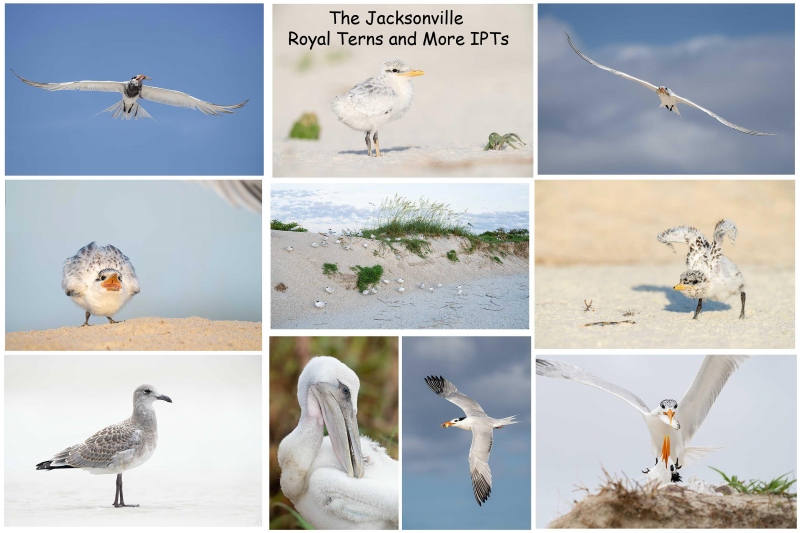
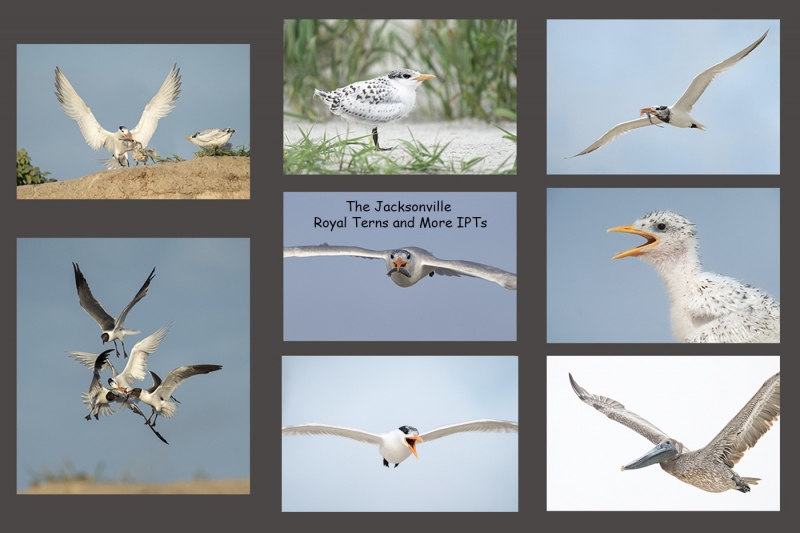
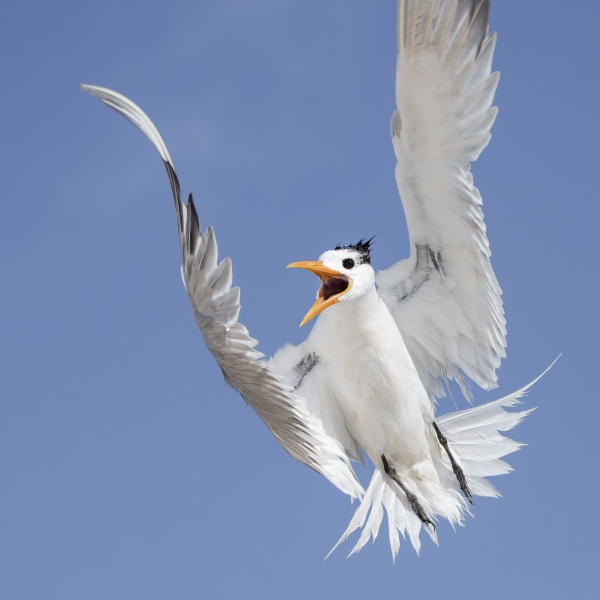
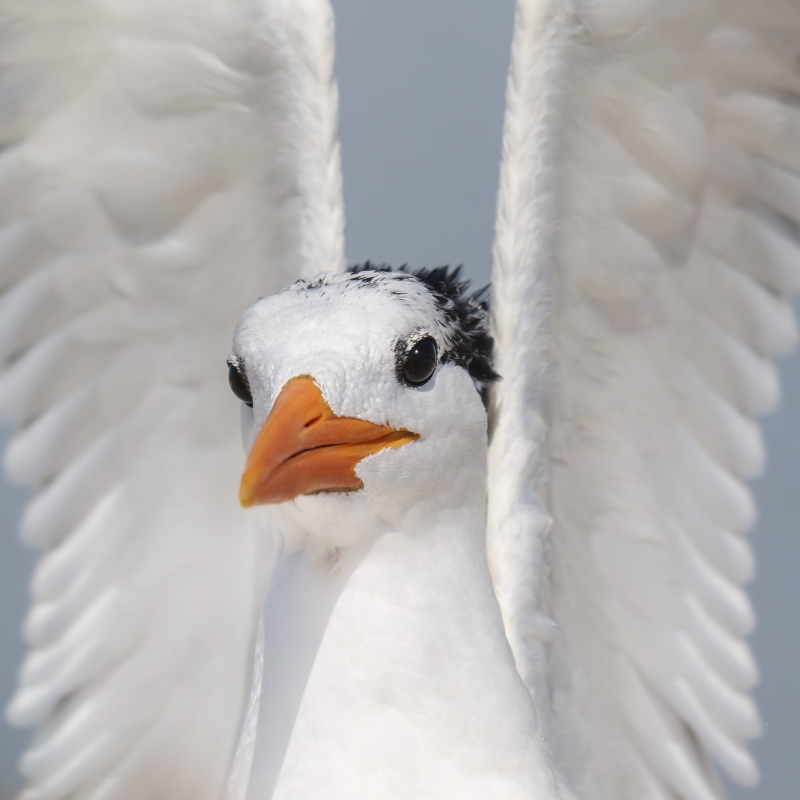
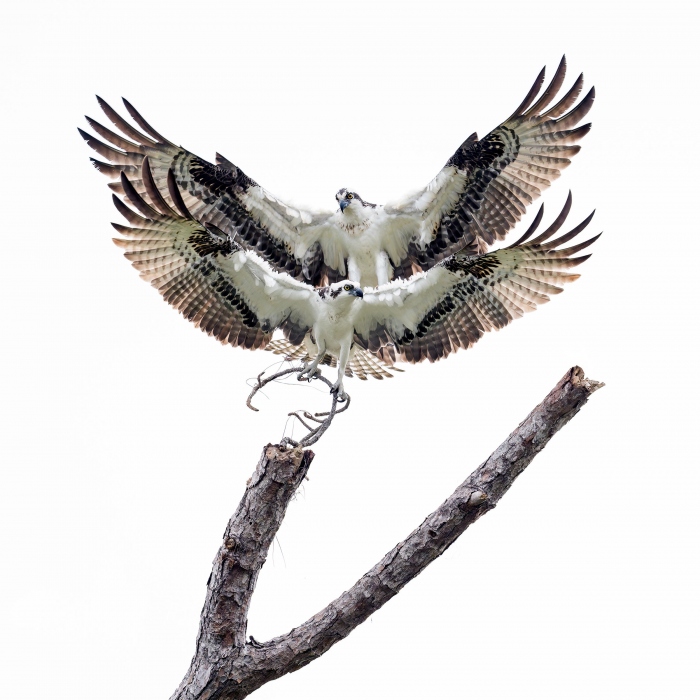













Thanks for leaving a comment, Andrew. Not sure what you mean when you say/imply (/) that all square crops are inherently symmetrical. But I agree with everything else you had to say.
Many folks look down their noses at square crops, but not you and I 🙂
with love, artie
Hi, Artie. I use square crops fairly often, most recently yesterday. I do think the clipped wing detracts from the image, but I absolutely love image #2. I also like image #3. Have you shared it with us previously?
Thanks for commenting as always, David. I actually like Image #1 better than Image #2. Go figure. And I am glad that I made something of it. The Osprey was on the blog in the Was This Image the Result of Pure Luck or the Right Gear? post here.
with love, a
I love image #1, especially as a square crop. The triangles in the lower right made by the negative space and by the tail is a nice anchor with the wing on the left side along with the bird’s gaze flicking your eye up and out. If this was 3:2 it wouldn’t have the dynamics that the current composition has. I don’t feel that having the wing clipped is a bad thing here.
Thanks on all counts and I agree with all them 🙂 Had I gone with anything but a square crop, there would have been a whole lot of blue sky to our right of the bird …
with love, artie
Square crops? In my very amateurish opinion (and this comment is not specific to bird photography), they can very often be better than 3:2 or 4:3 (or other medium formats). It’s stating the obvious to say that they are inherently symmetrical, but I also feel it can be easier for the eye to absorb a square image than a rectangular one (it may well be nonsense to say that, that is simply my impression).
More specifically with respect to birds, I completely appreciate that an image with a bird with outstretched wings may well not lend itself to being square but, when it works — and the image you included in today’s blog illustrates this perfectly — it can be really effective. It would be good to see more examples, it’s perhaps not that common to see bird photographs in this format?
(As it happens, I’ve been sorely tempted by the idea of an old Hasselblad 501 for some years. I need to resist this particular temptation, I really do!)
Andrew